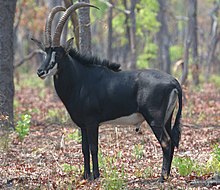| Antelope | |
|---|---|

| |
| Blackbuck antelope of India | |
| Scientific classification | |
| Domain: | Eukaryota |
| Kingdom: | Animalia |
| Phylum: | Chordata |
| Class: | Mammalia |
| Order: | Artiodactyla |
| Superfamily: | Bovoidea |
| Family: | Bovidae |
| Groups included | |
| Cladistically included but traditionally excluded taxa | |

The term antelope refers to numerous extant or recently extinct species of the ruminant artiodactyl family Bovidae that are indigenous to most of Africa, India, the Middle East, Central Asia, and a small area of Eastern Europe. Antelopes do not form a monophyletic group, as some antelopes are more closely related to other bovid groups, like bovines, goats, and sheep, than to other antelopes.
A better definition, also known as the "true antelopes", includes only the genera Gazella, Nanger, Eudorcas, and Antilope.[1] One North American mammal, the pronghorn or "pronghorn antelope", is colloquially referred to as the "American antelope", despite the fact that it belongs to a completely different family (Antilocapridae) than the true Old-World antelopes; pronghorn are the sole extant member of an extinct prehistoric lineage that once included many unique species.
Although antelope are sometimes referred to, and easily misidentified as, "deer" (cervids), true deer are only distantly related to antelope. While antelope are found in abundance in Africa, only one deer species is found on the continent—the Barbary red deer of Northern Africa. By comparison, numerous deer species are usually found in regions of the world with fewer or no antelope species present, such as throughout Southeast Asia, Europe and all of the Americas. This is likely due to competition over shared resources, as deer and antelope fill a virtually identical ecological niche in their respective habitats. Countries like India, however, have large populations of endemic deer and antelope, with the different species generally keeping to their own "niches" with minimal overlap.
Unlike deer, in which the males sport elaborate head antlers that are shed and regrown annually, antelope horns are bone and grow steadily, never falling off. If a horn is broken, it will either remain broken or take years to partially regenerate, depending on the species.[2]
- ^ Jana, Ananya; Karanth, Praveen (2019-10-01). "Multilocus nuclear markers provide new insights into the origin and evolution of the blackbuck (Antilope cervicapra, Bovidae)" (PDF). Molecular Phylogenetics and Evolution. 139: 106560. doi:10.1016/j.ympev.2019.106560. ISSN 1055-7903. PMID 31323336. S2CID 198135421.
- ^ Rue, Leonard Lee (3 September 2013). Book_Whitetail Savvy: New Research and Observations about America's Most Popular ... Section - Horns v/s Antlers. Simon and Schuster. ISBN 9781626365315.